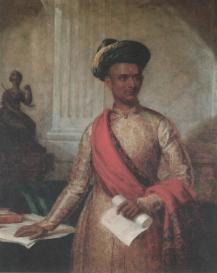Art & Raj: Visual Culture and British Imperialism in India c.1780-1900
Overview
Addressing works in a range of media - painting and the graphic arts, photography, sculpture, artefacts and architecture - produced by British and Indian subjects between c.1780 and c.1900, the course examines the role that these works played in the articulation of colonial power, desire, anxiety and resistance in ‘colony’ and ‘metropolis’ alike. The new visual forms which emerged in this encounter (whether late Mughal miniatures or late Victorian monuments) will therefore be analysed alongside the forms of their consumption and display, addressing aspects of collecting, commodification, exchange, and appropriation. In turn, the course will consider the colonial artefact’s relation to issues of knowledge, identity, memory and ritual. Drawing on a range of methodological approaches (including anthropological, historical and postcolonial theories), this course will reflect upon the possibilities of a transcultural analysis and consider its implications for the disciplinary practice of art history, conventionally rooted in the notion of the national and the concept of the autonomous artwork.
Aims
At the end of this module students should have acquired:
- a good grasp of a range of relevant artworks, artefacts and built forms produced by British and Indian subjects during the period in question
- an understanding of the contextual and methodological issues involved in their analysis
- an ability to articulate and apply current methodologies in the analysis of relevant artworks within class discussions and presentations
- an ability to deploy the knowledge and skills gained during the course in the production of an assessed research project
Preliminary reading
- Asher, Catherine, The Architecture of Mughal India (1992)
- Barringer, Tim and Tom Flynn (eds), Colonialism and the Object: Empire, Material Culture, and the Museum (1998)
- Bhabha, Homi, The Location of Culture (1992)
- Codell, Julie F and Dianne Sachko Macleod (eds), Orientalism Transposed: The Impact of the Colonies on British Culture, 1998
- Cohn, Bernard, Colonialism and its Forms of Knowledge: The British in India (1996)
- Davis, Richard, Lives of Indian Images (1999)
- de Almeida, Hermione and George H Gilpin, Indian Renaissance: British Romantic Art and the Prospect of India (2006)
- Dehejia, Vidja, Indian Art (2001)
- Dirks, Nicholas B, Colonialism and Culture (1992)
- Guha-Thakurta, Tapati, Monuments, Objects, Histories: Art in Colonial and Post Colonial India (2004)
- Guha-Thakurta, Tapati, The Making of a New Indian Art: Artists, Aesthetics and Nationalism in Bengal, c.1850-1920 (2007)
- King, Catherine (ed.), Views of Difference: Different Views of Art (1999)
- Latour, Bruno, We Have Never Been Modern (1993)
- Mathur, Saloni, India by Design: Colonial History and Cultural Display (2007)
- Metcalf, Thomas, An Imperial Vision: Indian Architecture and Britains Raj (2002)
- Mitter, Partha, Much Maligned Monsters: A History of European Reactions to Indian Art (1992)
- Mitter, Partha, Indian Art (2001)
- Nunn, Pamela Gerrish, Problem Pictures: Women and Men in Victorian Painting (1995)
- Pelizzari, Maria Antonella (ed.), Traces of India: Photography, Architecture and the Politics of Representation 1850-1900
- Pinney, Christopher, Camera Indica: Social Life of Victorian Photographs (1997)
- Rycroft, Daniel, Representing Rebellion: Visual Aspects of Counter-Insurgency in Colonial India (2006)
- Schimmel, Annemarie, The Empire of the Great Mughals: History, Art, and Culture (2006)
- Schmitz, Barbara (ed.), After the Great Mughals: Painting in Delhi and the Regional Courts in the Eighteenth and Nineteenth Centuries (2002 edition)
- Steggles, Mary Ann, Statues of the Raj (2000)
- Taussig, Michael, Mimesis and Alterity: A Particular History of the Senses (1993)
- Tillotson, Giles, The Artificial Empire: The Indian Landscapes of William Hodges (2000)
- West, Shearer (ed.), The Victorians and Race, 1996

Module information
- Module title
Art & Raj: Visual Culture and British Imperialism in India c.1780-1900- Module number
HOA00024M- Convenor
Jason Edwards
For postgraduates
